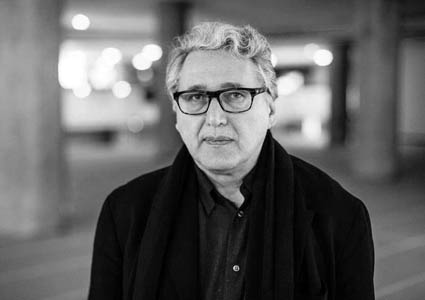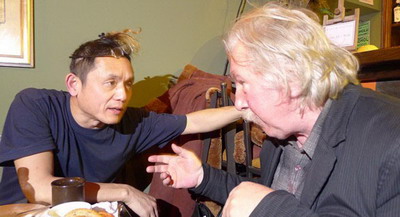
Talking with the master of performance art from Poland(Zbigniew Warpechowski 73years old, He start his first action at 1967)
辞旧迎新,让过去的事留在过去,让新的诱惑迎面而来,更新气象,希望在新的一年里有更多的喜悦!
我已同北京世界图书出版公司订了出书合同,明年6月将先后出版我的《行为艺术疗愈》与《行为艺术现场》两本书。在我前一本书的最后一章,向全世界我所熟悉的优秀行为艺术家发去了两个问题的问卷,获得了他们的回响。做为2011年的结束,为迎接2012年的到来,我在此彻底感谢一下对我工作支持的艺术家朋友。
New year, let the past stay in the past, the temptation to let new fascinate,more new scenes, We want to have more joy in the new year! I have make a contract with Beijing the world book company in to order the book published next June. They will publish my two books which about the performance art.In the last chapter of my frist book, I ask the artist of the world I am familiar with the excellent artists to the two questions and get their response. As the end of 2011, to meet the 2012, I would completely grateful for my support of artist friends.
8.4 世界各地行为艺术家的回复
我将以下二个问题以电邮的方式向全世界的一些优秀的行为艺术家发出,以下的排列顺序,是按他们回复的前后而来。每个艺术家朋友的反馈个有不同,有的肯定了行为艺术对心理治疗的作用;有的认为它对心灵扶慰有一定的帮助;有的不以为然,不认为这是行为艺术的重点。从这些回答中也展示出每个艺术家的创作个性,和在艺术上的追求。我认为无论怎样都有它的道理,我非常尊敬每个艺术家的意见,多谢他们的支持和在百忙之中回答我的问题。我想这个回答还是原样地保留在论文里,因为这是原汁原味的,是非常珍贵的,同时它给阅读者也提供了丰富的视角。在这里我仅对用英文回答的艺术家的短信做一个翻译。
1.如何在你的作品中考量互动的成分?
2.是否认为行为艺术有沟通心灵的作用,能够起到治愈的作用,如何在作品中注意这方面的尝试?
1.Do you consider interaction as an important factor in your performance? If so,how did you emphasize it?
2.Do you experience that performance art enhances the spiritual communication between you and the audience and hence generates therapeutic effect among the people involved? If so, how did you achieve it?

行为艺术家兼策展人陈进的回答:
我认为行为艺术有沟通心灵的作用,对我自己有起到心理治愈的作用。对他人就不一定了。
我没有想对他人有影响。事实上是会有一定的影响的。
Open performance art curator Chen Jing:
1. Some of my works do consider interactivity, but not all.
2. I believe so. It does have a therapeutic effect on me. I can’t speak for others.
I never think about whether it will have such an effect on others.
To some extent, I reckon there should be.
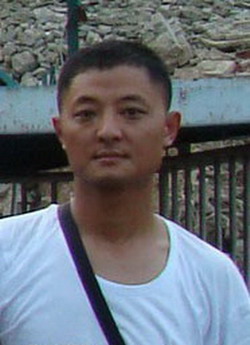
王楚禹对提问的答复:
1.首先,我理解的互动有很多种,与观众的互动,与场域的互动,与社会话语和场景的互动等等,不过 我们一般说的互动还是指与观众个体和群体的互动吧,就谈谈这个吧。
我把互动看作作品的社会性实现,这种实现在我看来是将自己的观念和思想拿出来进行"交往"的过程,交往不是寻找答案,而是相互侵入和影响的过程.行为艺术本身就是一种"不确定的实验"艺术,在开拓一个思想空间的努力中,行为艺术的重要特征之一就是互动性和交往性的中介艺术,既不代表开始也不是结束。与观众互动性,在我创作的时候比较注重与观众的心理互动,我认为这是行为艺术对互动因素的最高要求。 观众的行动参与是外在效果,只有心理参与才是实质的。具有文化性干预的互动,也具有思考的理解力.在我的作品中,心理互动往往让我的作品更多实现其文化的现实性价值。
2.艺术是心灵的衍生物,好的行为艺术会让观众从作品出发再次返回或接近于艺术家的心灵空间,所以 心灵的沟通不但是行为艺术的重要诉求,也是行为艺术的最高境界。行为艺术所表达的一切思想和观念,一切技巧和语言都围绕着心灵的开启而展开的。
行为互动的终极也是心灵互动 但行为互动未必能治愈心理疾病。 但互动会启示一个人的思想观念从而干预到心理层面,尤其是行为艺术语言所提供的一些认识事物的方法和其独特的表现手段会给人的心理"制造"空间和角度。这些角度和空间都涉及到心理影响,比思想观念更重要。
Chinese performance artist Wang Chuyu:
1. I think there are many kinds of interactivity … with the audience, the place,
the society, the performance space, etc, etc. Usually, however, we refer to interactivity
with the audience, whether individually or collectively done.
I see interactivity in performance art as a realisation of its social nature.
This realisation happens when one communicates one’s ideas, thoughts and viewpoints.
Such communication seeks no answers, but is meant to be a process of mutual exchange.
Performance art is a kind of ‘uncertain experiment’ involving interaction and ommunication.
It is not about the beginning or the end.
In interacting with the audience, I place more emphasis on the psychological aspect.
I believe this is what a performance artist demands most out of the interactive process.
The audience’s interactive action is an external effect. Only the psychological aspect is of actual value.
In my works, it is psychological interaction that produces a real cultural worth.
2. Good performance art enables the audience to communicate with the artist’s spirit in opening up
a space to generate ideas and notions through technique and language.
Interactive action culminates in spiritual interaction, but it may not heal any psychological illness.
It can create, rather, a psychological space that is more important than ideas and notions through performance language.
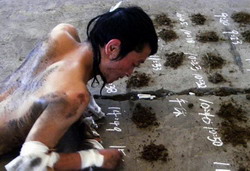
刮子对提问的答复:
1.我的很多现场作品都是很重视互动的,让观众在实施过程中参与进来或者和作品的参与者进行长期的连系、沟通,成为作品完成或者延续的一个重要方式。其实,几乎所有的作品都存在互动的可能,在我发表作品后有观众把他对我作品的认识反馈给我,这也是一种互动,艺术家和观众的互动。但我觉得更多的互动存在于作品本身和观众的互动,他们之间的故事可能艺术家本人都无从了解。
2.以身体为主要材料的行为艺术是更易于沟通心灵的,因为身体承载着心,而“灵”应该就是情感和艺术的部分。我把自己的工作一直当成心灵工作,希望并在作品中努力和观者互动,并相互影响。比如2006年起步的作品《十年》,我几乎每天都在QQ见到一些孩子,定时的会有些连系,这对我的生活有意义,对他们来讲也是好事情。《两条河》也是,因为艺术而建立起来的这种关系很细微的改变着我们的生活和情感。
Chinese performance artist Guazi:
1. I place much importance in interactivity to sustain a longterm sense of relationship
with participants. The audience’s response to my work is also an interactivity that even
the artist in me may not be able to understand its full implications.
2. The artist’s physical body in performance involves the ‘heart’ and the spirit.
I always take my art as spiritual work that interacts with the audience. For example,
“Ten Years” beginning in 2006, I go on QQ practically every day to get to know some children,
an activity that means a lot to both parties. Likewise with “Two Rivers”. The work builds up this
kind of relationship that changes our emotional lives.

周斌对提问的回答:
1.我创作实施一件作品的动机首先是自己内心的需要,我不刻意的考虑作品与外界的互动,我想,作品一旦发生,感知到、看到的人自然会有所反应,互动也就自然存在了。
2.人们内心的快乐、惆怅、茫然等等七情六欲都需要通过一种方式去表达,需要与外界沟通,行为艺术最大可能的调动了人的身心能量,是一种很好的表达与沟通方式,而表达的有效性在于真实,沟通的有效性在于真诚。
Chinese performance artist Zhou Bing:
1. My motivation is, first of all, a need to express inner thoughts and feelings.
I do not deliberately consider my performance in relation to its interactivity with the outside world.
I believe that once a performance happens, there will be an interactive response from the audience.
2. The audience’s sense of inner peace and happiness or alienation and loss,
all human emotion and desire may be well communicated through an interaction
with performance art that is real and honest.
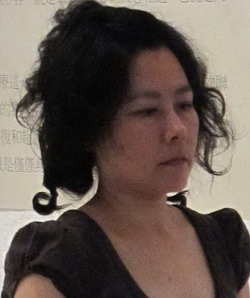
Tai Wan 台湾藝術家葉子啟答蔡青的提問
1.回頭看我許多作品的確包含與觀者互動成分﹐有些互動多些﹐作品從頭到尾都需要觀者參與;有些互動少些﹐只在某一部分需要觀者參與協助。而這些互動同時既封閉/又開放。封閉的是觀者在我指定的行動範圍裡幫助我完成作品。像《人卵 vs 動物卵》一作﹐觀者在我示範後上前來幫忙打蛋到容器裡。像《看手相》一作﹐路過的觀者坐下來讓我幫他們看手相﹐並依我指示寫下他們生命裡最重要人士的姓名。像《進與出》一作﹐觀者漸次進場﹐再漸次出場…。開放的是每個人打蛋方法各異。每人的手相各異,訴說不同的人生故事,寫下的名字有多,有少…。每個人進場出場的速度,姿態,方向,心情更是大異其趣。
這互動的成分於是將作品由我個人的抒發擴大到對他人或是群體的觀照與顯影﹐除了是藝術作品﹐也可以由社會學﹐人類學﹐ 心理學﹐或是文化研究…的層面來探討。
2.透過一件一件行為作品的發表﹐策展活動﹐與參與國內外的行為活動﹐我愈來愈了解自己。透過觀看其他藝術家的行為作品﹐我也愈來愈了解其他的藝術家﹐他們的藝術﹐他們的人。所以我認為行為藝術的確可以幫助自我溝通以及與他人的溝通。
至於行为互动能够起到心理治愈的作用吗﹐讓我這樣回答你﹐就像水﹐陽光﹐空氣﹐食物﹐自由和愛…﹐是我們每天需要的東西﹐我們並不會將之視為是醫藥用品﹐但是一旦我們失去其中之一﹐我們是會生病甚至失去生命的。這樣看來﹐這些東西其實也是良藥一帖了。
行為互動是否能夠起到心理治愈的作用?我想用治愈這樣的說法是太神了﹐生命裡最深的傷痛可以被治愈嗎?到今天我還沒有成熟到可以去諏嵜鎸σ约疤幚砩??幸恍┳钌羁痰耐�…。但行為藝術﹐不一定要互動﹐是可以起到某種程度的療傷﹐幫助我度過難關﹐對椎心的痛﹐憤怒﹐愧咎有某種程度的釋懷。像我作品裡的《黑暗》﹐《鞋子》﹐《人卵 vs 動物卵》﹐《擁抱》﹐《關於愛情二三事》都可算是這一系列的作品﹐其中《黑暗》與《關於愛情二三事》是獨立完成的作品﹐並沒有邀請觀者參與。
我在作品實施之前﹐多半還是只思考藝術層面的東西﹐比方說我在那個時間點想做什麼﹐關注的是什麼東西或事情﹐作品該怎麼做﹐諸如此類的考量。倒沒怎麼考量到心理治療這件事。
Chinese performance artist Ye Ziqi:
1. The degree of interactivity varies in my works. Interaction may be closed or open in nature.
In a ‘closed’ sense, I direct the audience to help me complete my performance, such as “Human Egg vs. Animal Egg”.
Or, “Palm Reading”, where people in the streets have their palms read by me. I further ask them to tell me
the name of the most important person in their lives. Or, say, “In & Out”, the audience
move according to my instructions. Yet, all the above examples also have an ‘open’ aspect.
Participants break eggs in their own fashion, no two palms are the same, they enter
and leave the performance space in different ways.
Interactivity connects the artist’s self to the community at large. Such performances
may be viewed as art as well as a social study in humanism, psychology or culture.
2. Through various performances and exhibitions, I understand myself more and more as well
as other artists when looking at their works. That is also another aspect of interactivity.
As to whether interactivity can provide psychological healing, let me just say that like water,
sunlight, air, food, freedom, love … these are things we need on a daily basis without regarding them as medicine,
yet any lack will threaten our lives. Perhaps to say that performance interactivity can be a psychological cure is stretching too far.
Can one be cured of the deepest emotional scar? Till today I don’t think I’m so mature in spirit as to be able to handle it.
In performance art, I think we don’t necessarily need interactivity to induce a curative effect. My works, “Darkness”,
“Shoes”, “Human Egg vs. Animal Egg”, “Embrace”, “On Love, Two or Three Things”, are some examples.
“Darkness” and “On Love, Two or Three Things” are totally independent of any audience in fact.
When creating a piece of performance art, I’m concerned about the mode of presentation and focus or such other aspects.
I do not deliberately consider any psychotherapeutic effect.

幸鑫对问题的答复:
1.关于创作中“互动”的概念,我把它分为两类:
一类是强制互动,就是作品中设计了必须观者直接参与的环节,如若无观者参与,作品将无法完成。
另一类是间接互动,就是通过作品的进一步实施,促使观者在心里与行为上趋于主动的去期待正在进行中作品的下一秒。由于观者们知识背景的多样性,也可能会出现某些观者主动介入作品现场的情况。
我对此两种与观者互动的方式都有过尝试,近两年我更喜欢在作品中运用第二种方式。
2.我认为凡是艺术都有沟通心灵的作用,但前提是不同的艺术和艺术作品所能感染的人群是不一样的。
行为互动是否能够起到心理治愈的作用,我认为是肯定的,但它的前提也是治愈的人群问题。同一件作品,只有刚好懂它的人才会觉得回味无穷,其余的观者只能说是在不同的程度上在进行体悟。
我的创作是用来治愈自己的,所以我只关注我喜欢如何做。而我的作品如何治愈他人,那是缘分所致。
Chinese performance artist Xing Xin:
1. I divide ‘interactivity’ into two categories. One requires the audience to enter into performance
at some point with the artist, or else it cannot carry on. The other is more a mediated way of working up
the audience’s psychological expectations until it may cause some members to intervene
into the performance to bring about an outcome. I’ve employed both kinds in my works.
In the past two years or so, I am inclined to the second type of interactivity.
2. I think all art forms have the capacity to communicate in spirit. Different forms affecting different people.
I’m affirmative about the psychotherapeutic effects of performance art, but a lot depends on who’s the audience as well.
Someone with knowledge of the art may find a performance memorable,
others could only be engaging it on varying levels of understanding.
I just attempt to heal myself through performance art. Whether it is of any psychotherapeutic use to others,
I should think depends on the vibes between the artist and the audience.
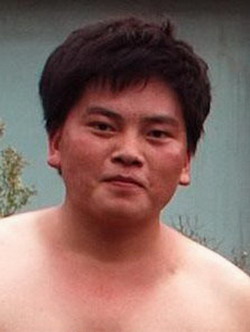
何利平对提问的回复:
1. 以前一段时间我把视觉作为我行为作品的一个重要考量部分。现在我更多的考虑观众的反应,即作品中的互动成分,有些可以是感触上的,有些则是行动上的,或者两者都有。例如激发起观众对生命的审视,亦或是愉快的参与体验。把观众从单一的欣赏再评价,转换成观众体验参与后再进行思考评价。由作者把他们微妙,自然的融入作品中,这样观众或许会有更深的体会。从而从互动的层面上提升作品,也让观众产生更多的思考。
2.既然观众乐意参与进作品中来,我想或多或少对观众都会有一定的感触。比如一个作品的内容对一些观众而言他们若是曾有过类似的思考,我想对他们的触动会更大,反之亦然。至于行为互动是否能够起到心理治愈的作用,我想应该是针对不同的个体有不一样的效果。至于我的作品中对“行为互动起到的心理治愈作用”这样一个思考方向,以前还未曾思考过,我想以后可能会在作品中做些尝试。
Chinese performance artist He Liping:
1. I used to rely heavily on visuals in my performances, but now prefer to focus on the audience’s response
through interactivity that may either be felt or acted upon or a bit of both. For example,
I may incite the audience into critiquing about life and then cast further interrogations
during a performance to raise the intensity of their experience.
2. Concerning the psychotherapeutic aspect of performance art, I think it probably has different effects on different people.
I might explore this notion further in some of my future performances.
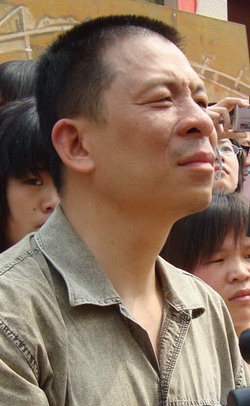
林一林回答如下:
1.如何在你的作品中考量互动的成分?
从来不考虑,有些作品做的过程中就有了。
2.是否认为行为艺术有沟通心灵的作用,行为互动能够起到心理治愈的作用吗,如何在你的作品中注意到这方面尝试的?
心灵沟通是很神秘的事,很难断定行为艺术是否起作用,每个艺术家和观众的感受会不一样。
Chinese performance artist Lin Yilin:
1. I never set my mind specifically on ‘interactivity’.
I guess some of my past works do have elements of it.
2. Communication in spirit is a mysterious matter.
It’s hard to determine if performance art has any definite effect on it.
The feelings of every artist and every audience are not the same.
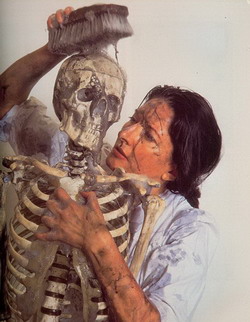
原南斯拉夫女行为艺术家玛丽亚.阿布拉莫维奇
Marina Abramovic's answer:
1. Yes, I think that interaction is an important factor in my performance, and not just toward the audience as a group, but on an individual basis. This is an experiment I conducted through my recent performance, The Artist is Present.
2. Yes, I do think that performance art enhances spiritual communication between the audience and me. If it is therapeutic it is not up to me, though,it is up to the audience.
Please look up more information about The Artist is Present, the performance for more information relating to both of your questions:
http:///interactives/exhibitions/2010/marinaabramovic/
译:1.是的,在我的行为作品中行为互动是很重要的方式,不仅是对于众多的人,而且是以独立的每个人为基础的。这也是我在近作“艺术家的在场”中所实验的。
2.是的,我的确认为行为艺术是可以与观众做精神性的对话。能否对人与心理治疗不是由我一方决定的,是由观众决定的。
请看下关于“艺术家的在场”资料,有许多方面与你的提问有关。
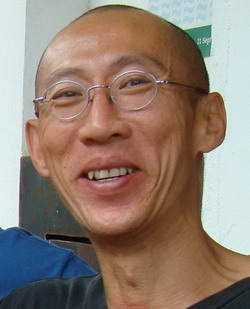
Singapore 李文对问题的回答:
Lee Wen answer the question:
1.Do you consider interaction as an important factor in your performance? If so, how did you emphasize it? i see performance art as a live presentation with intention that it is witness in real time. interaction varies and to me someone watching the artist is already an interaction. the presence of another person while one is doing something totally different from when one is alone. the degree of interaction will depend on what we do. i only reach out for audience participation if it is necessary to fulfill the completion of the performance. i feel many artists seek interaction and audience participation too easily thinking this is what a performance should be and end up asking us to do something that audience cannot relate to. i sometimes present situations where i ask audiences to help me do some actions, which makes it fun and a closeness amongst the willing audience who agree to participate. it is not so much that i wish to empahsize it but to share it.
我认为行为艺术是一个现场表演,并且考量到在场的观众。互动各种不同的表现方式,对我来说观众看艺术家也是一种互动。当一个人表演时有另外一个人存在是完全不同于独自的表演。互动的程度完全依从我们做什么了,如果必要的话我期望观众的参与去完成行为。我感觉许多艺术家寻求互动,观众轻易地参与认为这就是行为艺术了,最后要求艺术家去做一些观众无法理解的事情。有时我提供一种状况,我让观众帮助我做一些行动,使愿意参与的观众快乐并且更加接近。这并不是我刻意要强调的,而是与人共享。
2. Do you experience that performance art enhances the spiritual communication between you and the audience and hence generates therapeutic effect among the people involved? If so, how did you achieve it?your question is loaded with preconceptions and presumptions. it would be difficult to say yes or no. but i would say yes more than no. art to me is a spiritual experience and in a way which need not be subscribe to any particular religion it is a kind of secular common ground in our multicultural globalized society where i believe in some ways art may still fulfill its spiritual tasks whereas in the past were the domain of religions and other belief systems commonly held by traditional forms of social systems. and this include healing the ills of society. to me it is embedded in the process of art making and appreciating it in itself. how to achieve? live and make art and live.
你的问题是预想和假定。这很难说是和不是。但我要说是多于不是。艺术对我是精神经验和换司句话来说这是不需要被归类到任何一种信仰,它是在我们多文化的全球社会中一个世俗的共同基础,这个社会我相信在有些方面艺术仍然可以达成它的精神作用,就如同宗教及其它传统形式的信仰在过去所扮演的角色,这些包括治疗社会疾病。对我来说治疗的效果是在于创作过程以及对艺术的感激。如何达到?生活和创作和生活。
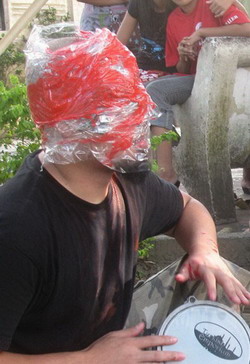
菲利宾行为艺术家sherwin carrillo's answer:
1. Yes, I consider interaction as one of the important factors of my performance because my performances are related to music and social realism. As we all know, music is a universal language.I interact with my viewer by producing sound through my djembe. When doing a performance, I want to create an image wherein I become a music device (e.g. MP3 player, IPOD, CD player,etc.) and my viewer becomes the listener.I believe that by making an interaction with your viewer is the most effective way to send your message.
2. Personally, performing and playing with my instrument (djembe) is a medium to express what is in my mind,body and soul which is in itself, a therapy. If it's therapy for other people involved? I cannot say, because it really depends on how the viewer will inject the message to him/herself.
译:1.是的,我认为行为中的互动是我的主要工作的方法,因为我的行为和音乐与现实社会生活有关。人们都知道音乐是全球性的语言。我的想法是通过我创造的音乐产生互动。当我做行为时,我想要创作一个景象,我使用音乐,观众成为音乐的欣赏者。我认为,最好传达你讯息的方式是通过互动。
2.从我个人来说,行为和演奏是表达我意念的媒介,身体和灵魂可得到自我疗愈。是否能给别人治愈,我不清楚,因为接收什么讯息完全依赖观众自己。
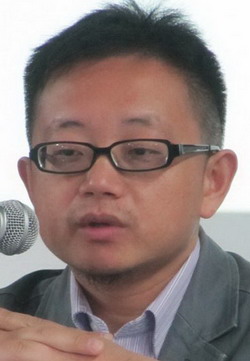
舒阳回答如下:
1.在作品构思开始,我就将观众的参与作为现场作品的一部分,我认为这是现场艺术不同于其他视觉艺术的最重要的部分。观众在我的现场作品中受到我的引导,根据我作品的主题来进行自我发挥。有时我的现场作品依靠观众,来共同完成作品。
2.是否认为行为艺术有沟通心灵的作用,行为互动能够起到心理治愈的作用吗,如何在你的作品中注意到这方面尝试的?
艺术本身就包括沟通心灵的作用,当然包括行为艺术。我认为行为互动能够释放艺术家与观众之间的对峙关系,在互动中形成释放相互紧张感的场域。我认为消除紧张感,能够起到心理治疗作用。
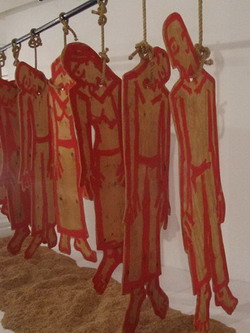
泰国艺术家Vasan answer:
I don’t seriously think about that, I try to control my action for keep on my concept to leave a message by my performance. Some time I do action with the audience or ask them to join together because it necessary to do with them.I do performance as natural act in everyday live even though it look very overact,too slow or so fast, it's happening and run by itself like I lose myself in a chance to be one in my work same as I do painting, singing a song, play music or reading poetry.I believe that everyone are performers.We do performance everyday but we don’t know we act as a life of a human being, but when they go to performance Art event they become the audience it means they are looking at themselves between time and space of an action, they focus all eyes and ears to concentrate and follow what’s going on. I can use any kind of objects to communicate my idea to the audience with new experience of each other. It's happening now like a explore of a poem a painting or a sculpture, so why I love to do performance Art .
译:我不太重视这方面,我试图通过我的行为持续传达我的观念。有时我与观众合作或当需要他们时请他们加入行为。我做行为趋于自然,行为来自于日常生活,使其得到强调,或更慢或更快,行为的发生和发展得顺其自然,有些像画一幅画,唱一首歌,玩音乐或读一首诗。
我认为每个人都可以做行为艺术。我们每天的日常活动就很行为,但我们不知我们的行为恰如人类的生活,但当他们去表演或是看表演,这意味着在时间和空间中观看自身,集中他们的所看与所听,去注意寻找将要发生的事。我可以用任何议题与观众经验和共享我的想法。这如同在发表一首诗,一个画或一个雕塑,所以我才这样喜欢做行为。
朱冥独个回答的提问:
1.首先我觉得"互动"是现在的一个流行词, 很表面化的一种行为参与. 而现在的很多所谓的行为艺术也只是有行为没艺术的杂耍! 我希望的是一种思维上的互动, 深层次的沟通, 在这一点上是没有形式的区别. 我最终目的是希望自己的思维体系能与参与者产生共鸣, 当然这肯定是极少数人的事情. 说实话我一直很讨厌"互动"这个词.
2.行为艺术当然有沟通心灵的作用, 但是必须是好的艺术. 不管是任何形式的具有独立思维的好艺术都有这样的作用, 当然也有心理治愈的作用, 而且能够让生命更有意义. 在我的作品中不需要刻意去做, 而是自然而然的事情,就像睡觉一样.
Chinese performance artist Zhu Min:
1. I think ‘interactivity’ is a voguish word for what may be some rather superficial participatory acts.
A lot of contemporary performance art today is just performance and no art.
I hope to practice a more ‘mindful’ sort of interactivity with a deeper sense of communication that
will reach out effectively to the audience. Frankly speaking,
I dislike using the ‘interactive’ word as a kind of broad term of convenience.
2. I’m sure performance art can communicate in spirit, but it will need to be of good quality.
Any art form with an independent capacity of thought ought to be able to do so. Of course,
we know its potential in psychotherapy, how it can sustain a more meaningful life.
In my works, I do not deliberately try to bring in psychotherapeutic elements.
I prefer to see it as something as natural as sleep to us all.
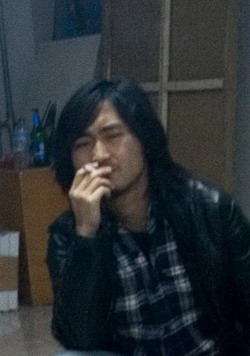
觋·高元回复关于蔡青的采访:
1.通常我会很重视这个问题,首先是否作品有需要互动的要求?如果有的话互动的一方是艺术工作者还是非艺术工作者?我想对于我的作品这都是很重要的。同时适合的互动也能更准确的将我的意图传达给观众,并且参与者的不同表现也会反馈给我所不知的可能性。
2.这个回答是肯定的。本人通过一年在工作坊的工作使大量非艺术工作者参与到其中,在与他们的交流里发现我们的身体在当下体制、环境中潜移默化的被改造着,这个过程中多数人并不可知,也就是他们并不了解自己的身体还有心灵,而不同程度的行为引导则使他们打开身体的同时心灵也有很大的影响。当我需要在自己的作品里需要有这方面尝试的时候我往往会首先想到一些词汇:克制的、隐藏的、暴力的、危险的等等这些,我想这些都是不为我们所知或者我们其实并不真实了解到的身体或者心理的角落。
Chinese performance artist Gaoyuan:
1. I place much emphasis on ‘interactivity’. I would ask, does the work need it? If so,
does it involve the artist or the nonartist? Suitable interactivity can convey my artistic intention effectively
to the audience and their responses will in turn reflect upon its potential I’m unaware of.
2. Certainly for psychotherapy. Based on my countless experiences with non-artists and participants, I can say that performance art helps to unlock the hidden spiritual side
often unknown to us in our lives. When experimenting with the potentiality of psychotherapy in my works,
I would think of a series of thoughts concerning suppressed emotions, hidden dimensions, violence, danger, etc, etc.
These things are largely still undiscovered or uncomprehended by us existing in some corner of the human body and psyche.
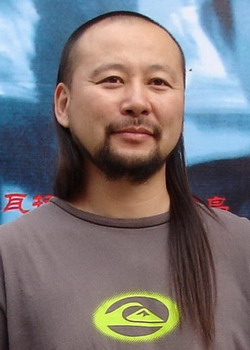
苍鑫回答问题:
1.关于互动的行为作品,我做过四个,踩脸,身份互换,苍式体操,天人合一。从早期开始考虑用身体-行动表达艺术观点时,我就考虑身体与权利、身体与社会、身体之间的操控与被操控、身体在自然时空中的关系,探讨身体在当下存在的语境中能产生出什么样的新的可能性。
a.踩脸(身体与权力):我一直以为身体在东方文化或文明中一直被处于一种权力的掌控之中,世界人口总数五分之三生活在亚洲,而中国是世上人口最大的国家,基本上是生活在农耕文明的基础上的一种社会结构中,它是以践踏身体为最大特征的暴力系统,此作品是以89年**学潮为时代背景而产生的一个行为互动作品。
b.身份互换(身体与社会):这个作品在四个国家用了将近5年的时间,意图从艺术家作为社会的旁观者或社会的游牧者,审视身份作为一个社会结构中人为制造出的一种游离状态。我不以为每个人的身份都是与生俱来的,它只是社会强加于人作为自然的存在体而强加于人身上的,所以艺术家是没有身份的边缘人。他可以成为任何职业者,但是他没有身份。
c.苍式体操(身体之间的操控与被操控):在中国五六十年代出生的人,小学、初中到高中都曾在学校里做广播体操,这种经历是权力下放到每个自然身体中的强力意志,而记忆深刻,是国家权力强迫每个年轻的生命锻炼体质的一种方法,现在回忆起来,觉得又好笑又可气。我用这种步调一致、整齐划一的集体动作来反讽对权力的结构,以达到艺术家的个人意志放大到群体中的强大作用。
d.天人合一(身体在自然时空中的关系),看标题就知道这是中国文化中经典的文人境界所要达到的最高标准,我不以为人类是自然中的精华所在,我更以为是人类是自然中的害虫,所以我把人的身体以最小的比例放到自然环境中,以反映人类一思索、自然就发笑。
2.我不认为行为艺术有沟通心灵的作用。我认为行为艺术:行动者与观看者是催眠与被催眠的关系,也是驾驭被驾驭者的关系,行为艺术家只是一个媒介,他是受灵感与激情的作用试图传达给观者一种开启智慧的钥匙和方法,我认为每个行为艺术家在做行为的过程中在制造密码,而观者是破译密码的钥匙。不是每个观者都有这种解码的钥匙,就会产生误读,而误读会产生新的歧义,所以你身体中必须具备这种能生成编码的能力才能称之为一个真正的媒介,而媒介不是以人的意志或客观存在为转移的,他只是在转译比人自身更大的能量存在体的意义而生成的。
我在作品中试图尝试“灵感”进入我头脑中的一瞬间是否感动了我自己,因为我也是个人。而我在行动中试图把这种感动传达给我互动中的同类。
Chinese performance artist Cang Xin:
1. I’ve done so far about 4 different kinds of interactive performances involving ‘face-stepping‘, identity exchange, body exercises and ‘tienren heyi’. Since the early part of my artistic career,
I’ve been thinking about the human body vis-à-vis power, society, as a centre of control/a controlled entity, time/space and language/narrative.
a. facestepping (body vs. power). I always feel that our human body is under the control of power in my Asian culture.
China’s agrarian society has had many major cultural instances of violent bodily destruction ordered through some mega-structure of systemic power. For example, I have devised a work from the Tiananmen Incident of 4 June, 1989.
b. identity exchange (body vs. society). Works on the artist as a social observer or nomad, all in all spanning
4 countries and nearly 5 years. I do not think one’s identity and status are birth attributes. They are products of social circumstances.
The artist is a ‘fringe’ personality able to take on any career, but does not possess any definite social status.
c. exercises (body as a centre of control/a controlled entity). Schoolers in China from the ‘50s to the ‘60s had to do mass exercises,
an example of delegation of power onto every ‘natural body’. The nation’s authority compelled every young life to a set of bodily
training that now seemed funny and frustrating to me whenever I recall those days of the past. I used the notion of these mass
exercises to devise a series of performances criticizing such centralized control on the individual body.
d. ‘tienren heyi’ or the heavens and man as one (body in its natural relation to time/space).
The Chinese learned man would aspire to such a state of highest perfection. I don’t think that man is
the essential spirit of nature. In fact, I think we are parasites.
2. I don’t think performance art has any effect in the communication of spirit.
I think the artist and the audience are engaged in a hypnotic relationship,
where one is in control and the other is being controlled. The artist is only a medium for transmitting
feelings of inspiration and passion.
I think the performance artist is always creating a secret code and the audience holds the key to breaking it.
Not every audience has the key, though, a situation which then leads to misreadings that produce new meanings.
So, your body needs to possess this capacity to create secret codes for it to be a true medium.
Moreover, a medium does not serve any personal drive or objective existence.
It transmit a larger body of meaning in the communicative process than the individual self.
In my works, I attempt to see if any feeling of inspiration entering the mind would move me.
After all, I’m also a human being. Through my performance,
I try to convey this emotion to interacting fellow human beings.
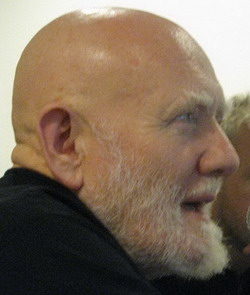
爱尔兰行为艺术家Alastair:
1) Interaction is important in (my) performance, whether the interaction is 'active'or 'passive'. I emphasize it by giving myself 'totally' to the action in hand,to the inter-relations involved, moment by moment, throughout the performance.
2) Art, to me, is the demonstrated wish and will towards resolving inner and outer conflict, through action, be it spiritual, religious, political, personal, social, or cultural...or any inter-fusion of these. To me, (real) art is the 'performance of living'...of how to manifest one's own true nature in relation to 'other'...on an ongoing basis. I practice Zen/Chan.
译:1)互动在我的行为中很重要,不管是“主动”的还是“被动”的都是如此。强调互动给我的全力以赴的自我掌控,通过行为的每一步,一点点融入一种联接。
2) 艺术于我,是证明希望与愿望化解内在与外在的冲突。通过行为,成为精神,宗教,政治,个性,社会或文化......或他们的任何混合。
对我来说,真正的艺术是表现生活......如何表现一个人的真实的自然与别人相遇的基础。我做禅。

国际黑市,德国艺术家Boris answer:
1.Do you consider interaction as an important factor in your performance?If so, how did you emphasize it?
No, it is not an important factor - because - to much one-dimension-communicatuion. A reaction between two (or more person). Very offen as a play with private or personal roles.a kind of referenceness. more important is the encountering in a topical field (looks like Black Market International). In this case the performance is more open and has various possibilities of communication, parallel and contradictorily (included some interaction). To frame a field in which the performer developed forms of communication and destroy these communication immediately.
A very open process without personal interaction
2.Do you experience that performance art enhances the spiritual communication between you and the audience and hence generates therapeutic effect among the people involved? If so, how did you achieve it?In this case, I don't believe in performance as a instrument of healing and not in therapeutical assistance as well. A political question. How you angling your live,how to communicate in your live and how you frame your position with others in this way, nobody will blessed mental, psychical or physical ? In this case, performance could grow up as a tool to develope a body in communication with cognition and knowledge.For my opinion, we don't need therapeutical awareness,we need strong performances to destroy the facts, which makes the bodys and the Individuals sick.
(译:1.不,这不是重点,因为有太多的沟通倾向。一种反应在二者(或更多人中),很常有的像是在表现私下的内容或个人的角色。是一种参考。
重要是在特殊的场域相遇(像国际黑市一样)。如此说来-行为是更开放和有更多对话的可能性,平行和抵触(包括一些互动)。去构造一个天地,由此发展或很快毁坏的对话。一个没有开放过程的个人互动。
2.由此我不认这,行为艺术可以成为一个治疗的或心理疗愈的工具。一个政治问题,你如何定位你的生活,如何反应你的生活和怎样在与别人相处的路上完成你的位置。没有人在乎智力,心理或生理问题?在此,行为艺术能够发展为促进身体认知和沟通的工具。我的观点是,我们不需要治疗的警告,我们需要的是有力的行为,让它催毁使身体和个人病症的现实。)
瑞士女行为艺术家Barbara:
1.In my performance is special way of interaction, i work not to produce concrete interact, i do not involving audience in my performances.It's more to open the possibility, that people start to think about something,to open spaces and freeing the mind. If so, how did you emphasize it?For some people it works and inputs reach the audience,it's possible,when audience takes the change.For me is OK, when nothing happens.And i feel specially toughed i can reach audience, i can bring people to start to think about,often i touch ta

